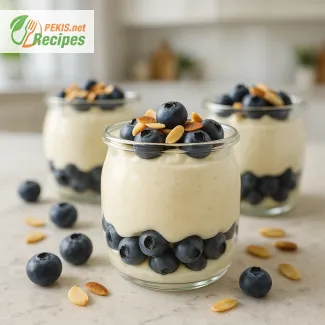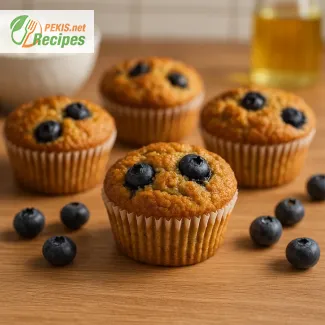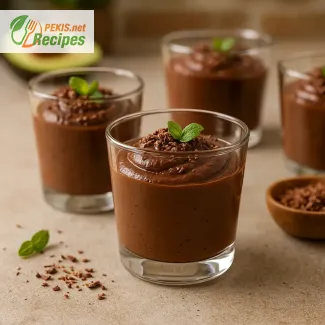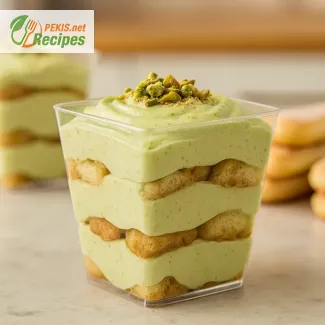A silky, high-protein cottage cheese dessert that tastes like a light cheesecake mousse, blending creamy cottage cheese, Greek yogurt, honey and fresh blueberries. Born from the modern protein-rich dessert trend, it delivers a smooth, airy texture with a bright hint of lemon and a crunchy almond finish.
Working with high-protein desserts for years shows how much texture matters, and one small change—blending cottage cheese long enough to turn it into a true cream—completely transforms the experience. A quick chill deepens the flavour and gives that cheesecake-like smoothness everyone loves.
PEKIS – professional chef and recipe developer with over 25 years of experience in cooking and baking, specializing in European and international cuisine.

Creamy high-protein cottage cheese dessert trend explained
How a simple cottage cheese treat turned into a global protein obsession
Spoon glides in with almost no resistance, sinking into a thick, whipped cloud of cottage cheese, kissed with a little natural sweetness, a swirl of fruit puree and the crunch of toasted nuts on top. One bite is all it takes to understand why this high-protein cottage cheese dessert is suddenly everywhere – it tastes like a cheesecake mousse, feels light on the palate, yet leaves that deeply satisfying, creamy finish usually reserved for far heavier sweets. It fits into busy weekdays, post-workout evenings and late-night cravings without feeling like a compromise.
What used to be a rather humble tub in the back of the fridge has quietly become the hero of protein-rich desserts. Blending cottage cheese until silky transforms the usual curds into a smooth, spoonable cream that takes on vanilla, cocoa, citrus zest or spices with ease. A small change in technique – blending, whipping, layering – turns an everyday staple into a dessert that looks and tastes like something from a modern café, but is built around protein-dense cottage cheese instead of heavy cream.
A brief look at the origin of the cottage cheese dessert trend
The idea of using cottage cheese in desserts isn’t new. Eastern European kitchens have long relied on tvaroh and quark for baked cakes and pancakes, while North American diet trends have cycled through cottage cheese bowls since the 1980s. What changed recently is the way home cooks present it: high-protein cottage cheese dessert bowls, whipped mousses and layered jars started appearing on social media, combining cottage cheese with Greek yogurt, berries, nut butters and crunchy toppings.
Healthy lifestyle creators reframed cottage cheese from “diet food” to indulgent-but-balanced dessert base, showing how easily it can mimic cheesecake, ice cream or pudding when blended and chilled. From there, the trend moved into baked high-protein desserts, like muffins and pancakes, where cottage cheese helps create a moist, tender crumb with extra structure and staying power.
Texture and flavour: why this dessert feels so indulgent
A great high-protein cottage cheese dessert is all about contrast:
- Creamy base – blended cottage cheese gives a velvety, slightly tangy base that holds air when whipped.
- Fresh fruit or compote – berries, cherries, mango or peaches add juiciness and natural acidity, cutting through the richness.
- Crunchy toppings – toasted nuts, seeds or crisp granola bring texture and nuttiness, so every spoonful feels layered.
- Balanced sweetness – honey, maple syrup, date paste or alternative sweeteners create a delicate sweetness, letting the dairy and fruit lead the flavour.
Depending on the ratio of cottage cheese to other ingredients, the dessert can lean toward dense cheesecake, light mousse or spoonable yogurt-style cream, making it easy to adapt for different tastes and occasions.
How cottage cheese and protein shape this dessert
Cottage cheese naturally provides a high amount of complete protein, which means the dessert doesn’t rely only on sugar and fat to feel satisfying. Pairing it with egg whites, Greek yogurt, protein-rich flours or nut butters can further boost the protein content, turning a simple bowl into a substantial snack or post-workout treat.
That protein structure also influences texture in baking. In muffins or bars it supports a tender but stable crumb, while in pancakes or oven-baked desserts it creates a fluffy, slightly custardy bite that holds moisture longer than many traditional sponge recipes.
Related high-protein cottage cheese ideas you can also try
If the idea of protein-packed desserts based on cottage cheese speaks to you, it’s worth exploring other forms too. For example, there is a recipe for Skyr-style cottage-cheese blueberry muffins with stevia – diabetic-friendly smart-oven dessert, where blended cottage cheese and berries bake into soft, juicy muffins designed for more controlled sweetness.
For a breakfast-meets-dessert option, Cottage Cheese Pancakes Recipe – Fluffy Protein Syrniki shows how cottage cheese can be turned into thick, golden pancakes that pair perfectly with fruit, yogurt or a spoonful of this dessert cream on top.
When to serve a high-protein cottage cheese dessert
This style of dessert fits naturally into several moments of the day:
- After the gym – a cold bowl of whipped cottage cheese dessert with fruit offers a satisfying, protein-rich option when you want something sweet.
- Weeknight dessert – quick to assemble from ingredients already in the fridge, yet elegant enough for the table.
- Breakfast or brunch – layered in jars with oats or granola, it becomes a dessert-like breakfast that still feels balanced.
- Afternoon snack – a small portion with fruit and nuts keeps energy steady and curbs cravings for heavier sweets.
Why you’ll love this high-protein cottage cheese dessert trend
- Creamy but light – offers the mouthfeel of cheesecake or mousse without the heaviness.
- High in protein – built around protein-rich cottage cheese, ideal when you want more than empty calories.
- Customisable sweetness – easy to use honey, maple syrup, dates or low-calorie sweeteners to fit different lifestyles.
- Endlessly adaptable – works as a bowl, layered jar, baked dessert, muffin filling or pancake topping.
- Quick to prepare – most versions rely on blending and chilling, not long baking times.
- Great for fruit lovers – pairs beautifully with fresh, frozen or roasted fruit, absorbing their juices and aroma.
Creative variations with cottage cheese, fruit and toppings
Once the basic idea is clear – creamy blended cottage cheese, something sweet, something crunchy – the possibilities multiply:
- Berry cheesecake bowl – blended cottage cheese with vanilla and lemon zest, topped with mixed berries and crushed biscuits.
- Chocolate protein mousse – cottage cheese mixed with cocoa powder, a hint of espresso and nut butter, then chilled until thick.
- Tropical jar dessert – layers of cottage cheese, mango puree, toasted coconut and lime zest in a glass.
- Breakfast crumble bowl – cottage cheese base with warm cinnamon apples and a sprinkle of homemade oat crumble.
- Salted caramel style – lightly sweetened cottage cheese with a salted date caramel swirl and roasted nuts.
Storage and make-ahead tips for cottage cheese desserts
Because the main component is fresh dairy, good storage is essential. Blended cottage cheese desserts keep best in the fridge in airtight jars or containers:
- Prepare the creamy base a day in advance, then add fruit and crunchy toppings shortly before serving, so they stay fresh and crisp.
- For grab-and-go snacks, portion the dessert into individual jars, keeping granola or nuts in a separate container and sprinkling them on at the last moment.
- Baked versions with cottage cheese, like muffins or bars, generally store well covered at cool room temperature for a short time, or in the fridge for longer freshness.
High-protein cottage cheese dessert in modern healthy cooking
This trend sits at the intersection of comfort food and performance-minded eating. It takes the classic desire for a creamy, sweet dessert and rebuilds it around high-protein ingredients, fresh fruit and thoughtful toppings. Instead of saving dessert only for special occasions, the high-protein cottage cheese version slips into everyday life – on busy mornings, study evenings, gym days and quiet weekends – always ready to be adjusted with a different flavour or topping to suit the moment.
- In a blender combine cottage cheese, Greek yogurt, honey, vanilla extract and sea salt. Blend until the mixture becomes completely smooth, creamy and without visible curds.
- Add lemon zest and blend for a few seconds to incorporate its aroma gently.
- Transfer the cream to a bowl and fold in half of the blueberries so they stay whole and juicy.
- Chill for at least 30 minutes so the texture firms and the flavour develops.
- Spoon the mixture into serving glasses or bowls.
- Add the remaining blueberries on top and sprinkle with toasted chopped almonds (decoration).
- Serve immediately or keep chilled until serving.
FAQ questionCan this high-protein cottage cheese dessert really taste like “real” cheesecake?
Yes, when cottage cheese is blended long enough, the curds disappear and turn into a silky, thick cream that feels very similar to cheesecake filling. Combining it with Greek yogurt, a touch of honey and vanilla builds that classic cheesecake flavour profile, while a short chilling time helps the mixture firm up slightly. The result is a light, mousse-like texture with a gentle tang that many people actually find fresher and less heavy than traditional baked cheesecake.
FAQ questionIs this cottage cheese dessert suitable for an evening snack or only post-workout?
This dessert works in both situations. Thanks to its high protein content from cottage cheese and Greek yogurt, it keeps you full longer than many sugary treats, which makes it ideal as a post-workout bowl with fruit and nuts. At the same time, the creamy, dessert-style texture and natural sweetness from honey and berries make it satisfying enough for an evening treat when you want something indulgent but not overly rich. The key is portion size and how much extra sweetener or toppings are added.
FAQ questionCan low-fat cottage cheese be used, or does it need to be full-fat?
Low-fat cottage cheese can definitely be used, but it will slightly change the mouthfeel and richness. Full-fat versions give a creamier, more luxurious texture, while low-fat cottage cheese creates a lighter, more refreshing dessert with a bit less “dessert decadence.” If using low-fat cottage cheese, blending thoroughly and pairing it with Greek yogurt and a small amount of healthy fat from nuts helps restore a smooth, satisfying texture without becoming heavy.
FAQ questionHow sweet is this dessert and can the sweetness be adjusted easily?
The sweetness level is very flexible. The base relies on honey and the natural sugars from blueberries, which creates a gentle, balanced sweetness rather than an intense sugary hit. For a less sweet version, simply reduce the honey and rely more on fruity toppings. For a sweeter dessert, a slightly larger drizzle of honey, maple syrup or a preferred low-calorie sweetener can be added at the end. Because the cottage cheese base is mild, it accepts adjustments without becoming cloying.
FAQ questionWhat toppings work best with a high-protein cottage cheese dessert?
The most successful toppings add contrast in texture and flavour. Fresh berries or stone fruit bring juiciness and acidity, toasted almonds or other nuts contribute crunch and nuttiness, while a sprinkle of granola provides a biscuit-like element that mimics cheesecake crust. A light dusting of cocoa powder or cinnamon, lemon zest or a spoon of berry compote also works beautifully. The goal is to keep the base creamy and smooth, and use toppings to bring layers of crunch, freshness and aroma.
FAQ questionHow far in advance can this dessert be prepared without losing texture?
The blended cottage cheese cream keeps well in the fridge for up to 24 hours, tightly covered, and often tastes even better after resting because the flavours meld and the texture firms slightly. However, berries and crunchy toppings are best added just before serving so they stay fresh and crisp. For meal prep, the base can be portioned into jars, then finished with fruit and nuts right before eating to maintain that creamy–crunchy contrast that makes the dessert so satisfying.
A smooth, high-protein dessert built on creamy blended cottage cheese delivers the kind of texture that feels indulgent while still fitting into everyday eating. Each spoonful blends gentle sweetness with the freshness of berries and lemon, creating a balance that works for both quick snacks and more intentional desserts.
The combination of Greek yogurt, honey and vanilla turns a simple base into something that tastes richer than expected, proving how versatile cottage cheese can be. The chilled, velvety consistency pairs naturally with crunchy almonds or fruit, giving every serving a layered feel.
This approach fits a modern style of cooking where convenience meets pleasure: minimal steps, clean ingredients, and a final bowl that feels satisfying without being heavy. The flexibility to adjust sweetness, toppings and flavour highlights how adaptable this dessert can be.
With a reliable structure, naturally high protein and a bright, fresh profile, this cottage cheese trend continues to stand out as one of the most accessible ways to enjoy a light but luxurious dessert any day of the week.
Allergens present in the recipe
- Dairy: naturally present in cottage cheese and Greek yogurt
- Nuts: almonds used as topping
- Gluten: none present
Ingredient swap tips to remove allergens and gluten
- Dairy: replace cottage cheese and Greek yogurt with soy-based or coconut-based alternatives for a fully dairy-free version.
- Nuts: use toasted seeds (sunflower, pumpkin) instead of almonds.
- Gluten: recipe is naturally gluten-free; ensure toppings used are certified gluten-free.
- Vitamin A (µg): 70 – supports vision and skin health
- Vitamin B12 (µg): 0.7 – essential for nerve function and red blood cell formation
- Calcium (mg): 160 – contributes to bone strength
- Magnesium (mg): 20 – supports muscle and nerve function
- Potassium (mg): 210 – helps fluid balance and normal muscle activity
- Phosphorus (mg): 190 – important for cellular energy and bone health
- Anthocyanins (mg): 38 – found in blueberries; support cellular protection
- Vitamin C (mg): 6 – boosts immune defence and antioxidant activity
- Polyphenols (mg): 55 – contribute to reduced oxidative stress





